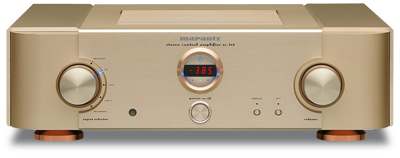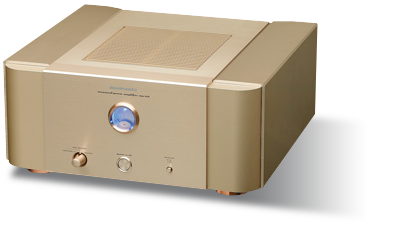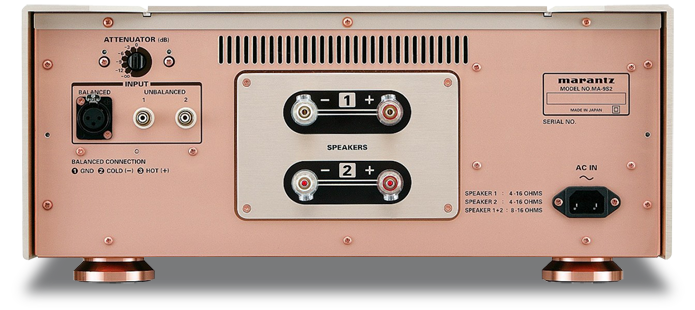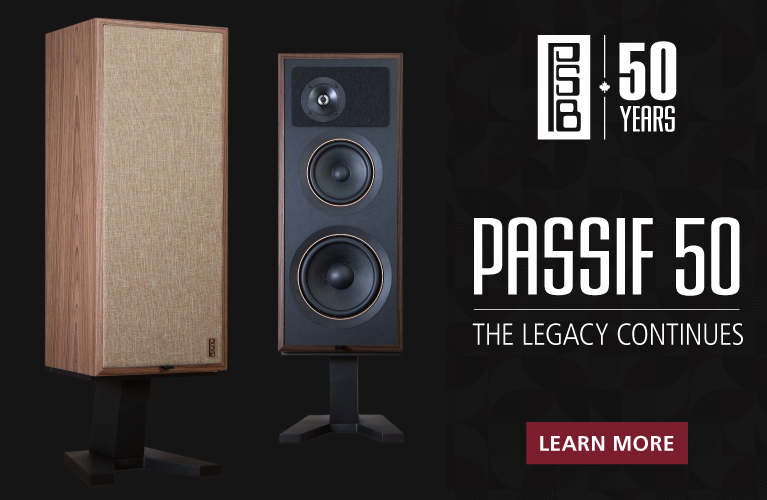
 In 1945, Saul Marantz, who was a musician and music lover but not a formally trained engineer, realized that he didn’t listen to his car radio all that much. He decided to remove it from his 1940 Mercury and put it in his house, where it would get more use. This took some electronic work, which Marantz enjoyed, so he kept on tinkering with his new home system.
In 1945, Saul Marantz, who was a musician and music lover but not a formally trained engineer, realized that he didn’t listen to his car radio all that much. He decided to remove it from his 1940 Mercury and put it in his house, where it would get more use. This took some electronic work, which Marantz enjoyed, so he kept on tinkering with his new home system.
Over the next several years, equipped with parts and information obtained from trips to the now defunct Harvey’s Radio, in New York City, Marantz developed a phono preamplifier he called the Audio Consolette. This preamp was unique in addressing the fact that, at the time, recording studios used several different standards for LP recording equalization, which made it impossible to properly play all LPs through a single preamplifier. The Audio Consolette solved this problem by internally incorporating many EQ curves, thus permitting it to correctly play almost any record.
Word of Marantz’s innovative device spread quickly among the then developing audiophile community. An enterprising sort, Marantz renamed the Audio Consolette the Model 1 and produced 100 of them, which he made available for purchase at Harvey’s. They quickly sold out, and Marantz found himself with an enormous backlog of orders. It was at that point, in 1953, that Marantz founded the company that bears his name.
In the 1950s and ’60s Marantz was joined by a number of talented, formally trained engineers, and his company manufactured a stream of very well-designed and high-performing tubed and solid-state components. These now classic devices include, among many others, the Model 9 mono amplifier, the Model 10B tuner, and the Model 18 receiver.
In 1967, Marantz left the company he’d founded, and in ensuing years the company’s ownership changed hands numerous times. However, the impact of the original company’s products on the hobby persisted. In 1974, for example, a young designer -- another musician and music lover who wasn’t a formally trained engineer -- approached Marantz to obtain an evaluation of one his first components. The name? Mark Levinson.
Saul Marantz, who some argue was the man most responsible for the birth of the high-end audio industry, died in 1997. For some time now, Marantz has been owned by D&M Holdings, a Japanese company that owns a number of audio brands, including Denon.
As I headed to the Marantz room during a recent audio tradeshow, I couldn’t help but wonder how many of the attendees were aware of the company’s glorious history. I also wondered how many of the show’s exhibitors would be in business 60 years from now.
When I arrived at my destination, I found the sound of the Marantz electronics to be extremely impressive. I also found James Ludoviconi, Marantz’s brand and product manager, who was more than happy to send me for review the SC-7S2 control amplifier, which is old-school audiospeak for preamplifier ($6499.99 USD); and two MA-9S2 monaural power amplifiers ($5999.99 each). Both are members of Marantz’s Reference Series and, respectively, descendants of two classic Marantz models: the Model 7 preamp and the Model 9 monoblock.
Reference Series SC-7S2 control amplifier
The front panel of the 48-pound Reference SC-7S2 contains a circular digital display, a remote-control sensor, and controls for power, input selection, volume, attenuation, and the brightness of the display.
On the rear is a pair of balanced XLR inputs, three pairs of single-ended RCA inputs for sources, and an additional pair of single-ended inputs for a tape/CD recorder. Outputs consist of a set of fully balanced XLR connectors, as well as three pairs of single-ended RCA connectors, including a recording output; a Floating Control Bus System input and a related switch, that, as discussed below, lets you connect one or more SC-7S2s to each other; a mode switch for selecting stereo or biamp operation; and a female AC receptacle.
The SC-7S2 is a current-feedback design, a very precise topology that reportedly avoids the sonic degradation caused by some traditional applications of feedback. The power supply is based on an aluminum-encased toroidal transformer. Each input is fully buffered with proprietary discrete circuits for accurate signal transfer. AC is converted to DC via Schottky barrier rectifier diodes, which are known to produce minimal noise. For power conditioning and distribution, the SC-7S2 uses low-ESR (equivalent series resistance) electrolytic storage capacitors, which are both efficient and quick to discharge, to produce excellent voltage on demand.
The digitally controlled analog volume control comprises four Wolfson WM8816 high-precision, multigang digital elements, and 12 proprietary Marantz HDAM-SA analog buffers. These form a circuit capable of 0.5dB resolution throughout its entire 100dB range. Thus, while the buffers are digitally controlled, the audio signal remains in the analog domain. Also, this fine level of resolution not only makes possible precise volume attenuation, but ensures that there are no noticeable signal imbalances between channels.

A thick chassis of copper-plated aluminum and a double-layered bottom panel provide structural stability, and isolate the SC-7S2’s internal circuitry from radio-frequency and electromagnetic interferences (RFI and EMI).
The SC-7S2’s total harmonic distortion is listed by Marantz as 0.0015% for a balanced connection and 0.003% for unbalanced (20Hz-20kHz). The frequency response is a claimed 3Hz-150kHz, +0/-3dB. Marantz also states that the SC-7S2’s signal/noise ratio is 105dB for a balanced connection, 108dB for an unbalanced connection (IHF-A).
As mentioned above, the SC-7S2 also contains a system that allows the simultaneous control of as many as six SC-7S2s, thereby accommodating multichannel recordings or a biamp stereo configuration. As for biamping, Marantz states that the best stereo performance can be obtained with two SC-7S2s connected to four mono amps. Of course, if you’re not quite ready to buy so many components, you can always use one SC-7S2 and two stereo amps.
Reference Series MA-9S2 monaural power amplifier
 The clean front panel of the 82-pound Reference MA-9S2 contains: a power switch, an input selector for two single-ended RCA inputs and one balanced XLR input, a circular blue display containing an output power-level meter and an illuminated power indicator, and a switch that turns the display on and off.
The clean front panel of the 82-pound Reference MA-9S2 contains: a power switch, an input selector for two single-ended RCA inputs and one balanced XLR input, a circular blue display containing an output power-level meter and an illuminated power indicator, and a switch that turns the display on and off.
The rear of the MA-9S2 has an attenuator to alter the input level, three switchable inputs (two single-ended, one fully balanced), biwirable WBT speaker outputs, and a female AC receptacle. As in the SC-7S2, isolation from external electromagnetic fields is provided by the MA-9S2’s copper-plated aluminum chassis and double-layered bottom plate.
The MA-9S2’s toroidal power transformer is the result of a proprietary “dual-hemisphere” design with electrical and vibrational isolation accomplished via a grain-oriented band of silicon steel housed in a case of damped aluminum. Low-noise Schottky barrier diodes are used in the power supply. The storage-capacitor bank is 50% larger than that used in the MA-9S1, which the MS-9S2 replaces. Marantz claims that this increase dramatically improves the bass response.
In addition to fully balanced differential design, the MA-9S2 uses current feedback implemented with six of the aforementioned HDAM-SA modules, which Marantz states provide for faster response and a low noise floor. Speaking of fast response, the HDAM’s slew rate of 200V/µs is impressively high. This specification indicates how fast the voltage rises from almost zero to almost full power -- or, in audiophile terms, the speed at which an amp can handle transients.
The MA-9S2’s power output is claimed by Marantz to be 300W into 8 ohms or 600W into 4 ohms. This ability to “double down” means that the MA-9S2 will drive low-impedance speakers well. It also means that, no matter how the speaker varies its load impedance as a function of frequency, the amp will maintain adequate current reserves to be able to output the correct voltage. Thus, the MA-9S2 will likely be able to drive the most demanding speakers at high volume for long periods.

Popping the cork
The Marantz review samples came to me triple-boxed -- a nice touch, and an early sign that the company really cares about its gear. Unboxed, the Marantzes’ color and luscious finish immediately grabbed my attention. Their color, officially listed as Gold, is really more a very classy champagne. They’re also gorgeously jewel-like. With their circular, nautical-style blue displays, they almost resemble something you might find on Captain Nemo’s submarine, the Nautilus.
In addition to appearance, the samples’ superb construction also clamored to be noticed. The build quality is second to none -- each component is heavy and built like the proverbial brick. Rapping any part of one of them produced nothing more than a dull thud and sore knuckles, without the faintest trace of cabinet resonance. This type of workmanship is not uncommon in components costing well in excess of $10,000. For their asking prices of about $6000 each, however, the Marantzes have few competitors that offer anything of the sort.
I set up the three components using Synergistic Research Tesla single-ended cables. Thanks to Synergistic for also loaning me a Tesla Hologram A power cord to match the one I was using for my reference stereo amp, the Bryston 6B SST2. The performance of these cables is impressive -- they greatly ease my identification of sonic differences between components, and thus the task of reviewing.
This ain’t the house of Moët & Chandon, but . . .
This review is not of a bottle of champagne, but it’s not that far off, either. Taken together, the Marantz Reference SC-7S2 and Reference MA-9S2 are for those who like their sound full-bodied, with healthy doses of sophistication and refinement. But these models did not achieve their meaty yet elegant sound at the expense of any significant sonic virtue. Perhaps even more noteworthy is that, given their good etiquette, they couldn’t be fairly criticized for sounding boring or too polite.
The Marantzes romanced me with their warmth and richness. However, unlike components that sound too warm, these sounded balanced -- neither saturated nor bloated -- in the 150-400Hz region, where the upper bass and lower midrange reside. For example, throughout Shirley Horn’s Here’s to Life (CD, Verve 314 511 879-2), her voice came across naturally, brimming with emotion, and without too much thickness.
The Marantzes soundstaged wide and deep, and were a touch laid-back: With Here’s to Life, they placed Horn’s voice slightly to the rear of where I’d been accustomed to hearing it, particularly when my Audio Research DAC8 was paired with my Marantz UD9004 universal Blu-ray player. Nonetheless, I couldn’t say that this new position was actually incorrect.
Details were not only well resolved; when faced with complexity, the Marantzes were able to accurately sort it out. This is not always easy to do. “Money,” from Yes’s Tomato (CD, Rhino R2 73794), contains a self-styled “satirical broadcast” by keyboardist Rick Wakeman that’s laid atop Jon Anderson’s vocals. Wakeman is pretending to be Denis Healey, a former British politician who earned the scorn of at least a few of the country’s rock stars for his support of high tax rates for the wealthy. Careful listening to the track revealed that even where the enunciations intertwine, the inflection, air, and resonance of Anderson’s Lancastrian-accented voice remained intact.
Slam was more than adequate to convey the explosiveness and grandeur of large-scale orchestral works. At no time did I feel, for example, that the Marantzes were guilty of softening the percussive attack of the bass drum in Carl Orff’s Carmina Burana (CD, Usher Audio Test Disc, Dancer Series II). Sure, it’s possible to find equipment that can bring even a bit more heft to the table with this track. However, such equipment is either more expensive than the Marantzes or lacks some other sonic virtue, such as the ability to deliver notes with stunning inner detail -- something the Marantz combo did in spades.
As my neighbors can attest, the Marantzes could play loud without ever losing their composure while driving my MartinLogan Summit X electrostatic speakers. Conservative type that I am, I didn’t test this finding to the limit, preferring to let some other owner of electrostats blow his speaker’s power-supply modules while trying.
A final note about sound warrants a discussion of the SC-7S2 preamp separate from that of the MA-9S2 amplifiers. Some preamps I’ve heard have more fully scrubbed the sonic dirt off the sounds of the organ and synthesizer in Steve Winwood’s Chronicles (CD, Island D134501). Yet the SC-7S2 didn’t leave me feeling that it lacked transparency, which it didn’t. Moreover, many of the preamps that offer additional transparency come across with too little sonic brawn, or can’t match the luxurious sound and palpable, almost tube-like midrange of the SC-7S2. Again, others simply will take a bigger bite out of your wallet. Also noteworthy is that, as discussed below, I found the MA-9S2 amplifiers to be very transparent. They were a great match for the SC-7S2.
While the Marantzes revealed no significant sonic flaws, one weakness of the SC-7S2 is its remote control. Standard Marantz issue, it’s unremarkable save for its small buttons, which I found difficult to read in a dimly lit room. Although the remote’s poor showing is far from a deal breaker, it’s disappointing in not connoting, at least in my mind, reference quality. And unlike the similar-looking remote of Marantz’s UD9004 universal player, the SC-7S2’s lacks an on/off button. James Ludoviconi told me that this feature was omitted from the Reference models because it can introduce noise to the circuit.
All in all, the Reference MA-9S2 and Reference SC-7S2 proved to be extremely fine components that could go head to head -- and then some -- with a number of very well-regarded competitors. When it came time to send them back to Marantz, I was genuinely saddened.
Champagne taste vs. beer budget
I compared the Marantz Reference SC-7S2 and Reference MA-9S2 to my current references, the NuForce P-9 preamplifier and Bryston 6B SST2 stereo amplifier, which respectively retail for $3150 and $7295. While not exactly from beer-budget territory, they collectively cost nearly 50% less than the Marantzes. I’ve previously noted in reviews that the NuForce and Bryston swing way above their league in terms of performance. That proposition would now decisively be put to the test.
The SC-7S2 sounded softer, warmer, cleaner, and quieter than the NuForce P-9. It was also more refined, more tonally correct, more resolving, and more liquid. Despite this, the NuForce refused to go down for a TKO. It, too, hit hard, in this case literally, with better transient impact. Although its sound was less cultivated, the NuForce was also more transparent, offering a more lively presentation of high-level frequencies. This was despite the fact that the Marantz’s upper end was extended and nearly without fault.
All in all, it would be easy to conclude that, sonically, the SC-7S2 would be more at home in the urbane environment of a really high-end system. However, the NuForce is undoubtedly an exceptional deal for $3150. Of course, associated equipment and tastes can vary -- one audiophile’s lively and energetic sound, for example, can be another’s fatiguing, over-agitated upper end. Prospective preamp purchasers should listen to the P-9 or something of its ilk just to illustrate the sonic differences between these models.
Also, the P-9’s remote control is an ergonomic delight, and a model by which all remotes should be judged. Easy to hold, it’s shaped like a hexagonal wand, with really large buttons that are few in number and a cinch to find in the dark, even without backlighting. However, as set forth in Vade Forrester’s review of the NuForce P-9, each click of its remote’s volume button can alter the volume by as much as 5dB, thus frequently necessitating a trip off the couch to get the volume just where you want it, via the analog control on the front panel. This is because the P-9 uses a relatively low-resolution stepped digital volume control via its remote, and a high-resolution, non-stepped analog Alps pot on the faceplate.
Volume control was not, however, a problem with respect to the Marantz SC-7S2’s remote. In fact, the remote’s ability to manipulate the SC-7S2’s volume was flawless -- using it to do so gave me the feeling that I was operating a finely crafted precision machine.
Comparing the Reference MA-9S2s to my Bryston 6B SST2 stereo amplifier also turned out very favorably for the Marantz camp. Save for heft and slam, the MA-9S2s outperformed the Bryston in virtually every category, sometimes by a lot, sometimes by a little. Both were very powerful, yet musical and capable of producing great finesse. However, the Marantz monoblocks sounded more tonally accurate, liquid, and precise, and had better bass than the Bryston. They also sounded more detailed. With “Love Is Green,” from Jeff Beck’s Wired (CD, Epic EK 85439), for example, the Marantzes revealed the plucking of Beck’s acoustic guitar strings in a more articulate and pronounced manner. While this shouldn’t be surprising, given the large price differential between the two models, it was still impressive -- the Bryston amp is no slouch.
Notably, the sound of the Marantz MA-9S2s was ever so slightly warmer, more relaxed, more laid-back than that of the Bryston. What I thoroughly enjoyed about the MA-9S2s, though, was that their slight touch of warmth was not, as with some amps, accompanied either by midrange-frequency congestion or by a lack of treble extension or transparency. In fact, transparency was one of this amp’s hallmarks.
Also, I would be remiss if I did not discuss these models’ warranties. For amps and preamps, Bryston offers an incredible 20-year warranty, Marantz gives five years, and NuForce three. This is something that prospective purchasers should consider.
Champagne wishes and caviar dreams
Being the offspring of Marantz’s classic Model 7 preamplifier and Model 9 amplifier, the Reference SC-7S2 and Reference MA-9S2 have some rather large shoes to fill. By my account they do just that, and the folks at Marantz appear to be worthy stewards of the historic company name. If you’re looking for a pair of amps and/or a preamp anywhere near or even above these models’ asking prices, you’ll want to head to your local Marantz Reference dealer to give them a listen. Just don’t forget to pick up a bottle of the bubbly on the way over. In the event that you make the purchase, you’ll have much to celebrate.
. . . Howard Kneller
howardk@soundstagenetwork.com
Associated Equipment
- Speakers -- MartinLogan Summit X
- Amplifier -- Bryston 6B SST2
- Preamplifier -- NuForce P-9
- Source -- Marantz UD9004 universal Blu-ray player modified by Tube Research Labs, Audio Research DAC8
- Interconnects -- Synergistic Research Tesla Apex, Precision Reference, Synergistic Research Galileo MPCs on all signal cables and power cords
- Speaker cables -- Synergistic Research Tesla Apex
- Power cords -- Synergistic Research Tesla Hologram A (amplifier) and D (source), Precision AC (speakers and Powercell 4 power conditioner), Precision AC SE (Powercell 10SE power conditioner), T2 (preamplifier)
- Power conditioners and distribution -- Synergistic Research Powercell 10SE (power and analog) daisy-chained to Powercell 4 (digital), Synergistic Research QLS 6 and 9, PS Audio Noise Harvesters, DIY parallel filter
- Isolation devices -- Silent Running Audio VRfp Isobases, Synergistic Research MIGS, Mapleshade Heavy Hats, DIY amp stands
- Misc. -- Synergistic Research Galileo Universal interconnect and speaker cable Cells
Marantz Reference Series SC-7S2 Preamplifier
Price: $6499.99 USD.
Marantz Reference Series MA-9S2 Mono Amplifiers
Price: $5999.99 USD each.
Warranty (both): Five years parts and labor.
Marantz America, Inc.
100 Corporate Drive
Mahwah, NJ 07460-2041
Phone: (201) 762-6500
Fax: (201) 762-6670
Website: www.marantz.com






















